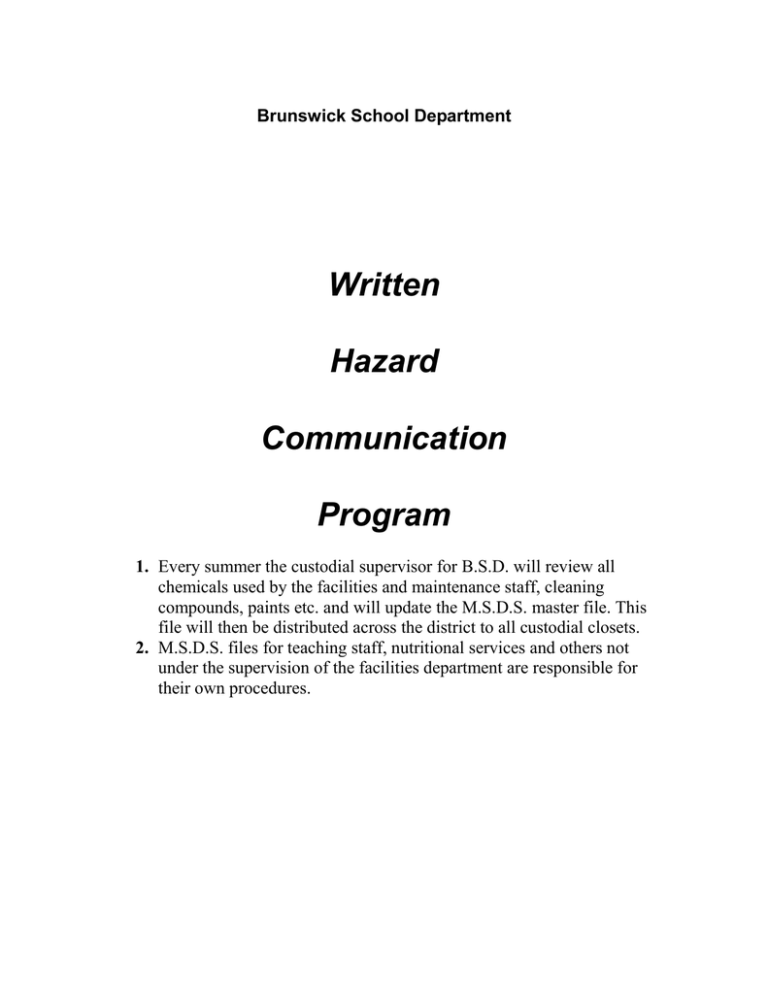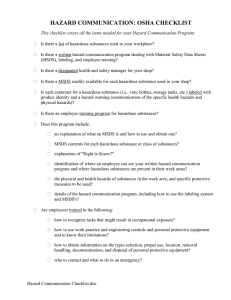Written Hazard Communication Program
advertisement

Brunswick School Department Written Hazard Communication Program 1. Every summer the custodial supervisor for B.S.D. will review all chemicals used by the facilities and maintenance staff, cleaning compounds, paints etc. and will update the M.S.D.S. master file. This file will then be distributed across the district to all custodial closets. 2. M.S.D.S. files for teaching staff, nutritional services and others not under the supervision of the facilities department are responsible for their own procedures. Brunswick School Department Written Hazard Communication Program 3. Policy – 29 CFR 1910.1200(e) Brunswick School Department has established this Hazard Communication Program in order to comply with 29 CFR 1910.1200, OSHA’s Hazard Communication Standard, and to provide a safe and healthy workplace. All work units are included under this program. The written program will be available for review by any employee during work hours. It is located in the main office of each school. The Facilities Director will review and update the program at least annually and whenever necessary to include new hazardous materials or procedures. The written program will be made available to employees, their designated representative, the Assistant Secretary for Labor for OSHA, the director of the National Institute for Occupational Safety and Health (NIOSH), and the Bureau of Labor Standards. I. Container Labeling – 29 CFR 1910.1200(f) The Facilities Director will verify that all containers of hazardous substances are properly labeled. The Facilities Director will review the labeling system at least annually and update as needed. The Facilities Director will answer questions or provide help on labeling. The container labeling system used shall be of the original manufacturer, importer, or responsible party design. If none is available, then the HMIG system shall be used. Hazard ratings used shall be obtained from the MSDS of the substance. Original containers received for use will be labeled to indicate, at a minimum: The identity of the contents. The identify must match the MSDS, Appropriate hazard warnings, including routes of entry and target organs if known, and 07/25/16 2 Brunswick School Department Written Hazard Communication Program The name and address of the manufacturer, importer, or responsible party. Secondary containers will be labeled with, at a minimum: A copy of the original manufacturer’s label, or Generic label with identity and hazard warnings. 07/25/16 3 Brunswick School Department Written Hazard Communication Program II. List of Hazardous Chemicals – 29 CFR 1910.1200(e)(1)(i) The Facilities Director is responsible for preparing and updating the list of all chemicals in our workplace that are potentially hazardous. The definition of a hazardous chemical is anything that we do not normally rub on our skin and/or normally ingest. If the original label has any of the following words on it: CAUTION, WARNING, FLAMMABLE, that product is a hazardous chemical. The following is a partial list of hazardous substances used by employees of this school district. Art Supplies Ammonia Battery Acid Bleach Biology Lab Chemicals and Experiments Chemistry Labs Chemicals Circuit Board Etching CO2 Tank Custodian Cleaning Supplies Cutting Oil Denatured Alcohol Drano Duplicating Fluid Ethyl Alcohol Fabric Dyes Fire Extinguishers Floor Finish Floor Finish Stripper Heating Oil Glue Ink Iodine Kitchen Cleaning Chemicals Kerosene Oil Stains Office Products ( markers, pens, printer inks, white-out, etc. ) 07/25/16 4 Brunswick School Department Written Hazard Communication Program Oxygen Paint Thinner Photocopy toner Polymer Paints Propane Fuel Rubber Cement Rubbing Alcohol Sanding Sealer Varnish 07/25/16 5 Brunswick School Department Written Hazard Communication Program III. Material Safety Data Sheets (MSDS) – 29 CFR 1910.1200(g) The Facilities Director is responsible for a system that receives, distributes and maintains the MSDS. The Facilities Director will review incoming MSDS’s to make sure they contain all required information, and for changes in health and safety information. He/she will make sure any new information is passed on to the affected employees. When toxic or hazardous substances are received without the MSDS, the Business Office will send a letter to the supplier requesting the MSDS and will withhold payment until the MSDS is received. Employees are not permitted to use any chemicals for which the company does not have the MSDS. MSDS will be accessible to all employees during each work shift when they are in their work area. Copies of MSDS will be kept in the following location(s): The Director of Facilities Office (district wide copy) The Main Office of each school (copy of the MSDS that apply to that School only) Individual High Hazard Areas: Custodian Closets Nurses Office Maintenance Areas Kitchens Art / Photography 07/25/16 Science Areas Industrial Arts 6 Brunswick School Department Written Hazard Communication Program IV. Employee Information and Training – 29 CFR 1910.1200(h) The Facilities Director is responsible for the employee training program. He/she will ensure that all elements specified below are carried out. The Facilities Director is responsible for assuring that each affected employee will be given information as outlined below for any new chemical prior to that chemical being introduced into the workplace. The Facilities Director is responsible for providing yearly update training, as required by the Maine Chemical Substance Identification Law. Prior to starting work, each new employee of this school district will attend a health and safety orientation and will receive information on the following: An overview of the requirements contained in the OSHA Hazard Communication Standard, 29 CFR 1910.1200. Chemicals present in their workplace operations. Location and availability of our written hazard communication program. Physical and health effects of the toxic or hazardous substances. Methods and observation techniques used to determine the presence or release of toxic and hazardous substances in the work area. How to use toxic and hazardous substances in the safety possible manner, including safe work practices, personal protective equipment and emergency procedures. Steps the company has taken to lessen or prevent exposure to toxic and hazardous substances. How to read labels and review MSDSs to obtain correct hazard information. Location of MSDS 07/25/16 7 Brunswick School Department Written Hazard Communication Program V. Hazards of Non-routine Tasks – 29 CFR 1910.1200(e)(1)(ii) Periodically, employees may be required to perform non-routine tasks that involve the use of Hazardous chemicals ( for instance, a custodian using hydrochloric acid to remove graffiti ). The Facilities Director will provide information about hazardous chemicals to which employees may be exposed during non-routine tasks prior to employee starting such tasks. This information will include: Specific hazards involved. Protective measures the employee should take. Measures the company has taken to lessen the hazard, including ventilation, respirators, presence of another employee, and emergency procedures. Examples of non-routine hazardous tasks at this school district: TASK HAZARDOUS SUBSTANCE None known at this time. 07/25/16 PROTECTIVE MEASURES 8 Brunswick School Department Written Hazard Communication Program VI. Informing Contractors – 29 CFR 1910.1200(e)(2) The Facilities Director will provide contractors with employees at our school district the following information: Toxic and hazardous substances to which the contractor’s employees may be exposed while at the worksite. Precautions the employees can take to lessen the possibility of exposure. Location of MSDS The Facilities Director will contact each contractor before work is started in our school district to gather and disseminate any information concerning chemical hazards that the contractor is bring into our workplace. He/she is responsible for ensuring that any employees of our company who are exposed to these hazards are properly trained and protected. 07/25/16 9


